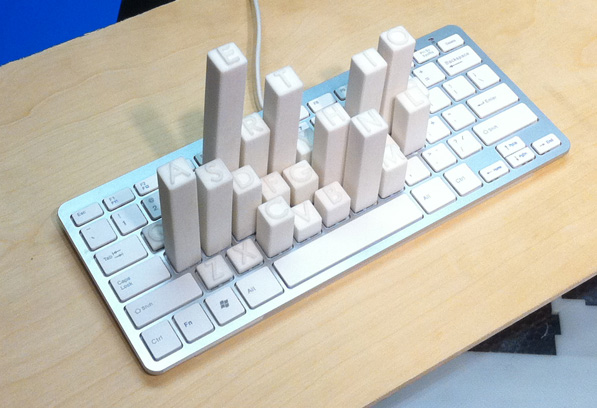Mike Knuepfel, a student in NYU’s Interactive Telecommunications Program, uses key frequency, according to Wikipedia, to build a keyboard sculpture. Taller keys equals higher frequency.
Conclusions – This was just a first go at trying to create a data driven 3d sculpture. I wound up scaling the keys a little bit too much in the vertical direction. The weight of the tall keys caused the towers to tilt at an angle. I plan on showing this prototype to a few people that will hopefully give me more ideas for new data sets to look at. I want to try and use the CNC for future data driven sculptures. I also want to try and include color into the sculpture somehow.
Not bad for a first run. My proposed next step: Sculpturize the entire computer. You’ve got your keyboard. Next use some tracking software for mouse button clicks, and then use this software to track the mouse pointer for a sculptured monitor.


 Visualize This: The FlowingData Guide to Design, Visualization, and Statistics (2nd Edition)
Visualize This: The FlowingData Guide to Design, Visualization, and Statistics (2nd Edition)

I have another suggestion: change the layout to Dvorak to show a comparison.
This is letter frequency not key frequency, so a little misleading to represent on a keyboard. What would be interesting is TRUE key frequency, i imagine it would feature the spacebar, enter key etc on par with ‘e’ or ‘a’
That depends on what you are trying to show.
If it’s a layout for typing then I don’t think this is really an issue.
The frequency of the shift key being used with letters would be interesting.
I agree with ergonomnoms that it’s a little confusing to call this key frequency, but I don’t think the other keys need to be included. Maybe it would be best if those unmapped keys got a different color?
Make an animated sculpture, with key (or letter) frequency varying by the language used (and/or the type of document?).
The keyboard layout would be changing as well, so you have to make the actual key markings dynamic too, but I’m sure you can make it :-)
I looked on this wikipedia article and one thing come to my mind: similarity between countries based on letters frequency. Some data manipulations and voilà http://i.imgur.com/zzRpi.png
R code for plot: http://pastebin.com/XKnktQxr
Along with key strokes and mouse clicks, eye tracking software could also provide a data set to represent in some fashion.
The inverse on the keys could be interesting as well, with the keys depressed by how much they a used.
An eye tracking heat map on the surface of the computer screen AND the keyboard would be interesting. would look very much like a warped terrain model.
There should be different segments – imagine a first person shooter gamer, WASD would be huge. Or finding the key strokes of a novel would be equally as interesting. Love the idea and execution, heaps of room for expansion.
I second that!
Also worth considering: different kinds of users.